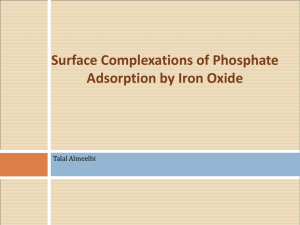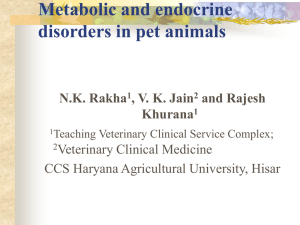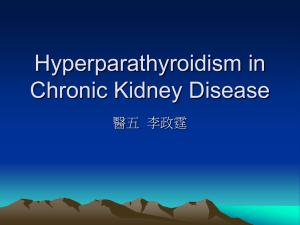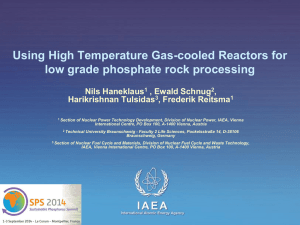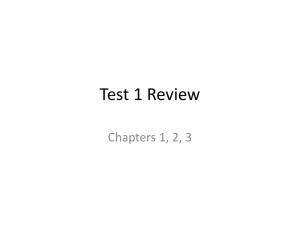jarmes ip poster liz - Animal Sciences
advertisement
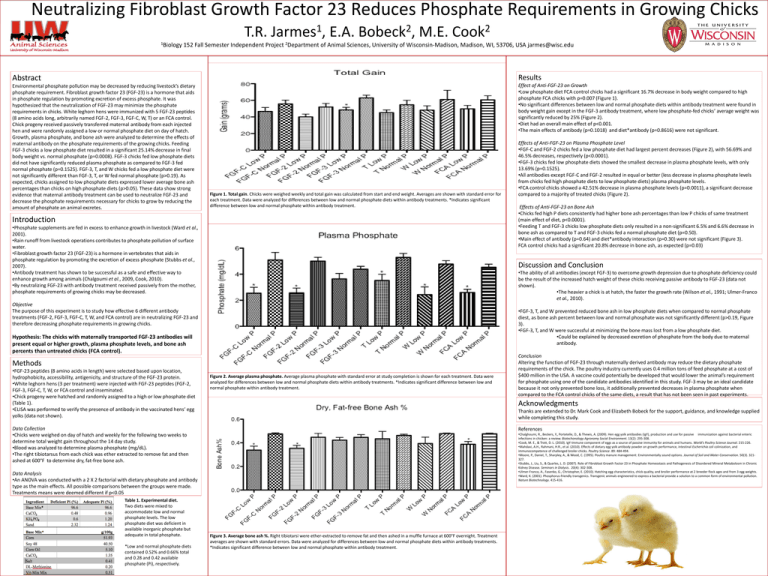
Neutralizing Fibroblast Growth Factor 23 Reduces Phosphate Requirements in Growing Chicks T.R. 1Biology 1 Jarmes , E.A. 2 Bobeck , M.E. 2 Cook 152 Fall Semester Independent Project 2Department of Animal Sciences, University of Wisconsin-Madison, Madison, WI, 53706, USA jarmes@wisc.edu Abstract Results Environmental phosphate pollution may be decreased by reducing livestock’s dietary phosphate requirement. Fibroblast growth factor 23 (FGF-23) is a hormone that aids in phosphate regulation by promoting excretion of excess phosphate. It was hypothesized that the neutralization of FGF-23 may minimize the phosphate requirements in chicks. White leghorn hens were immunized with 5 FGF-23 peptides (8 amino acids long, arbitrarily named FGF-2, FGF-3, FGF-C, W, T) or an FCA control. Chick progeny received passively transferred maternal antibody from each injected hen and were randomly assigned a low or normal phosphate diet on day of hatch. Growth, plasma phosphate, and bone ash were analyzed to determine the effects of maternal antibody on the phosphate requirements of the growing chicks. Feeding FGF-3 chicks a low phosphate diet resulted in a significant 25.14% decrease in final body weight vs. normal phosphate (p=0.0008). FGF-3 chicks fed low phosphate diets did not have significantly reduced plasma phosphate as compared to FGF-3 fed normal phosphate (p=0.1525). FGF-3, T, and W chicks fed a low phosphate diet were not significantly different than FGF-3, T, or W fed normal phosphate (p>0.19). As expected, chicks assigned to low phosphate diets expressed lower average bone ash percentages than chicks on high phosphate diets (p>0.05). These data show strong evidence that maternal antibody treatment can be used to neutralize FGF-23 and decrease the phosphate requirements necessary for chicks to grow by reducing the amount of phosphate an animal excretes. Effect of Anti-FGF-23 on Growth •Low phosphate diet FCA control chicks had a significant 16.7% decrease in body weight compared to high phosphate FCA chicks with p=0.007 (Figure 1). •No significant differences between low and normal phosphate diets within antibody treatment were found in body weight gain except in the FGF-3 antibody treatment, where low phosphate-fed chicks’ average weight was significantly reduced by 25% (Figure 2). •Diet had an overall main effect of p<0.001. •The main effects of antibody (p=0.1018) and diet*antibody (p=0.8616) were not significant. Figure 1. Total gain. Chicks were weighed weekly and total gain was calculated from start and end weight. Averages are shown with standard error for each treatment. Data were analyzed for differences between low and normal phosphate diets within antibody treatments. *Indicates significant difference between low and normal phosphate within antibody treatment. Introduction •Phosphate supplements are fed in excess to enhance growth in livestock (Ward et al., 2001). •Rain runoff from livestock operations contributes to phosphate pollution of surface water. •Fibroblast growth factor 23 (FGF-23) is a hormone in vertebrates that aids in phosphate regulation by promoting the excretion of excess phosphate (Stubbs et al., 2007). •Antibody treatment has shown to be successful as a safe and effective way to enhance growth among animals (Chalgoumi et al., 2009, Cook, 2010). •By neutralizing FGF-23 with antibody treatment received passively from the mother, phosphate requirements of growing chicks may be decreased. •The ability of all antibodies (except FGF-3) to overcome growth depression due to phosphate deficiency could be the result of the increased hatch weight of these chicks receiving passive antibody to FGF-23 (data not shown). •The heavier a chick is at hatch, the faster the growth rate (Wilson et al., 1991; Ulmer-Franco et al., 2010). •FGF-3, T, and W prevented reduced bone ash in low phosphate diets when compared to normal phosphate diest, as bone ash percent between low and normal phosphate was not significantly different (p>0.19, Figure 3). •FGF-3, T, and W were successful at minimizing the bone mass lost from a low phosphate diet. •Could be explained by decreased excretion of phosphate from the body due to maternal antibody. Hypothesis: The chicks with maternally transported FGF-23 antibodies will present equal or higher growth, plasma phosphate levels, and bone ash percents than untreated chicks (FCA control). Methods Figure 2. Average plasma phosphate. Average plasma phosphate with standard error at study completion is shown for each treatment. Data were analyzed for differences between low and normal phosphate diets within antibody treatments. *Indicates significant difference between low and normal phosphate within antibody treatment. Thanks are extended to Dr. Mark Cook and Elizabeth Bobeck for the support, guidance, and knowledge supplied while completing this study. References •Chalghoumi, R., Beckers, Y., Portetelle, D., & Thewis, A. (2009). Hen egg yolk antibodies (IgY), production and use for passive immunization against bacterial enteric infections in chicken: a review. Biotechonology Agronomy Social Environment. 13(2): 295-308. •Cook, M. E., & Trott, D. L. (2010). IgY-Immune component of eggs as a source of passive immunity for animals and humans. World's Poultry Science Journal. 215-226. •Mahdavi, A.H., Rahmani, H.R., et al. (2010). Effects of dietary egg yolk antibody powder on growth performance, intestinal Escherichia coli colinization, and immunocompetence of challenged broiler chicks. Poultry Science. 89: 484-494. •Moore, P., Daniel, T., Sharpley, A., & Wood, C. (1995). Poultry manure management: Environmentally sound options. Journal of Soil and Water Conservation. 50(3). 321327. •Stubbs, J., Liu, S., & Quarles, L. D. (2007). Role of Fibroblast Growth Factor 23 in Phosphate Homeostasis and Pathogenesis of Disordered Mineral Metabolosm in Chronic Kidney Disease. Seminars in Dialysis. 20(4): 302-308. •Ulmer-Franco, A., Fasenko, G., Christopher, E. (2010). Hatching egg characteristics, chick quality, and broiler performance at 2 breeder flock ages and from 3 egg weights. •Ward, K. (2001). Phosphorus-friendly transgenics. Transgenic animals engineered to express a bacterial provide a solution to a common form of environmental pollution. Nature Biotechnology. 415-416. Data Analysis •An ANOVA was conducted with a 2 X 2 factorial with dietary phosphate and antibody type as the main effects. All possible comparisons between the groups were made. Treatments means were deemed different if p<0.05 *Low and normal phosphate diets contained 0.52% and 0.66% total and 0.28 and 0.42 available phosphate (Pi), respectively. Conclusion Altering the function of FGF-23 through maternally derived antibody may reduce the dietary phosphate requirements of the chick. The poultry industry currently uses 0.4 million tons of feed phosphate at a cost of $400 million in the USA. A vaccine could potentially be developed that would lower the animal’s requirement for phosphate using one of the candidate antibodies identified in this study. FGF-3 may be an ideal candidate because it not only prevented bone loss, it additionally prevented decreases in plasma phosphate when compared to the FCA control chicks of the same diets, a result that has not been seen in past experiments. Acknowledgments Data Collection •Chicks were weighed on day of hatch and weekly for the following two weeks to determine total weight gain throughout the 14 day study. •Blood was analyzed to determine plasma phosphate (mg/dL). •The right tibiotarsus from each chick was ether extracted to remove fat and then ashed at 600°F to determine dry, fat-free bone ash. Table 1. Experimental diet. Two diets were mixed to accommodate low and normal phosphate levels. The low phosphate diet was deficient in available inorganic phosphate but adequate in total phosphate. Effects of Anti-FGF-23 on Bone Ash •Chicks fed high P diets consistently had higher bone ash percentages than low P chicks of same treatment (main effect of diet, p<0.0001). •Feeding T and FGF-3 chicks low phosphate diets only resulted in a non-significant 6.5% and 6.6% decrease in bone ash as compared to T and FGF-3 chicks fed a normal phosphate diet (p=0.50). •Main effect of antibody (p=0.64) and diet*antibody interaction (p=0.30) were not significant (Figure 3). FCA control chicks had a significant 20.8% decrease in bone ash, as expected (p=0.03) Discussion and Conclusion Objective The purpose of this experiment is to study how effective 6 different antibody treatments (FGF-2, FGF-3, FGF-C, T, W, and FCA control) are in neutralizing FGF-23 and therefore decreasing phosphate requirements in growing chicks. •FGF-23 peptides (8 amino acids in length) were selected based upon location, hydrophobicity, accessibility, antigenicity, and structure of the FGF-23 protein. •White leghorn hens (3 per treatment) were injected with FGF-23 peptides (FGF-2, FGF-3, FGF-C, T, W, or FCA control and inseminated. •Chick progeny were hatched and randomly assigned to a high or low phosphate diet (Table 1). •ELISA was performed to verify the presence of antibody in the vaccinated hens’ egg yolks (data not shown). Effects of Anti-FGF-23 on Plasma Phosphate Level •FGF-C and FGF-2 chicks fed a low phosphate diet had largest percent decreases (Figure 2), with 56.69% and 46.5% decreases, respectively (p<0.0001). •FGF-3 chicks fed low phosphate diets showed the smallest decrease in plasma phosphate levels, with only 13.69% (p=0.1525). •All antibodies except FGF-C and FGF-2 resulted in equal or better (less decrease in plasma phosphate levels from chicks fed high phosphate diets to low phosphate diets) plasma phosphate levels. •FCA control chicks showed a 42.51% decrease in plasma phosphate levels (p=0.0011), a significant decrease compared to a majority of treated chicks (Figure 2). Figure 3. Average bone ash %. Right tibiotarsi were ether-extracted to remove fat and then ashed in a muffle furnace at 600°F overnight. Treatment averages are shown with standard errors. Data were analyzed for differences between low and normal phosphate diets within antibody treatments. *Indicates significant difference between low and normal phosphate within antibody treatment.


